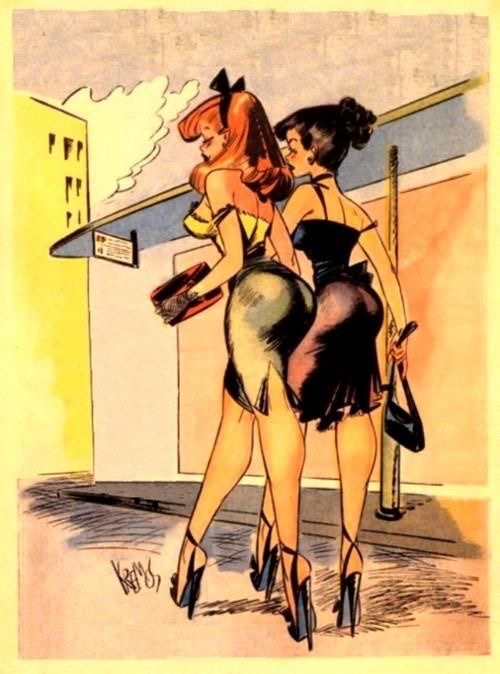#kremos art
Text
‘Sexy scooter!’

Artist: Niso Ramponi (‘Kremos’), (1951)
#pin up style#pin up art#comic book art#pin up cartoon#good girl art#sexy#pulp art#pin up pose#scooter#pin up poster#niso ramponi#kremos
49 notes
·
View notes
Text
ALMANACCO DEL 40° FESTIVAL DI MONTE-CARLO - EDIZIONE 2016

ALMANACCO DEL 40° FESTIVAL DI MONTE-CARLO – EDIZIONE 2016
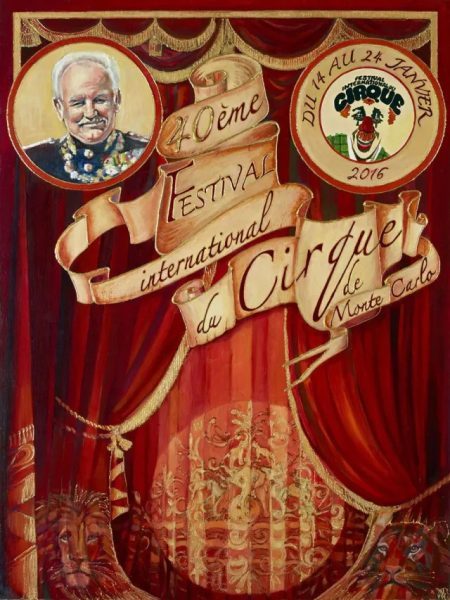
In occasione della 40° edizione del Festival il Principato ha battuto sé stesso proponendo l’edizione più sensazionale che si potesse immagine. Un’edizione senza competizione, che ha portato in scena tutti gli artisti premiati con Oro e Argento nelle precedenti edizioni ancora in attività per un omaggio al Circo senza precedenti. E per l’occasione anche artisti che non lavoravano più in pista sono tornati appositamente per questa edizione per dar vita a momenti iconici come quello dei tre domatori (ispirato ai “Tre Tenori) Pavlenko, Massimiliano Nones e Martin Lacey nella stessa gabbia. O il trio di clown composto da Housch-ma-Housch, Fumagalli e Nock. O ancora il quadro dei verticalisti con i Pellegrini, i Peres ed Encho, lo straordinario ritorno dei Rastelli (con Vittorio che eccezionalmente prese il ruolo del padre Alfredo nell’entrata) affiancati dal bianco Alexis. O ancora il quadro equestre che ha visto insieme Flavio Togni e Alex Gruss in un momento da brividi. David Larible, intanto proponeva il suo one man show al Teatro Principessa Grace. Questo è molto altro è stata la 40 edizione che nonostante non prevedesse la competizione, a sorpresa ha visto assegnare un Clown d’Oro alla Principesse Stephanie, aggiungendo emozioni indimenticabili a una serata leggendaria scolpita nella Storia del Circo.
ELENCO PARTECIPANTI
2016
FUMAGALLI & DARIS
CLOWN
SHCHERBACK & POPOV
MANO A MANO
PELLEGRINI BROTHERS
MANO A MANO
FLIGHT OF DESIRE
FANTASIA AEREA
TROUPE SOKOLOV
BASCULE
TROUPE ACROBATICA DI PECHINO
SALTI NEI CERCHI
TROUPE ACROBATICA DI PECHINO
DIABOLO
FLAVIO TOGNI
CAVALLERIA
FAMIGLIA CASSELLY
ELEFANTI
BELLO NOCK
CLOWN
ENCHO
EQUILIBRISTA
PERES BROTHERS
MANO A MANO
KELLY HUESCA
SAND ART
STARBUGS
COMICI ECCENTRICI
DUO SKATING PILAR
PATTINATORI ACROBATICI
ANASTASIA MAKEEVA
TESSUTI AEREI
KRIS KREMO
GIOCOLIERE
ROSI HOCHEGGER
CANI
HOUSCH MA HOUSCH
CLOWN
STEVE ELEKY
COMICO
TROUPE ACROBATICA DI CANTON
PASSO A DUE
WILLER NICOLODI
VENTRILOQUO
ALEXIS GRUSS
CAVALLERIA
CATWALL
TRAMPOLINO ELASTICO
LAURA MILLER
CERCHIO AEREO E ACQUA
I RASTELLI E TONITO ALEXIS
ENTRATA MUSICALE
TROUPE BINGO
FANTASIA AEREA
FLYING TABARES
TRAPEZIO VOLANTE
MARTIN LACEY JR
LEONI & LEONESSE
IL BALLETTO DEL CIRCO DI STATO DI MINSK
BALLERINE
PETIT GOUGOU
M. LOYAL
RETO PAROLARI
ORCHESTRA

S.A.S. PRINCIPESSA STEPHANIE RICEVE IL CLOWN D'ORO


CATWALL ACROBATIC
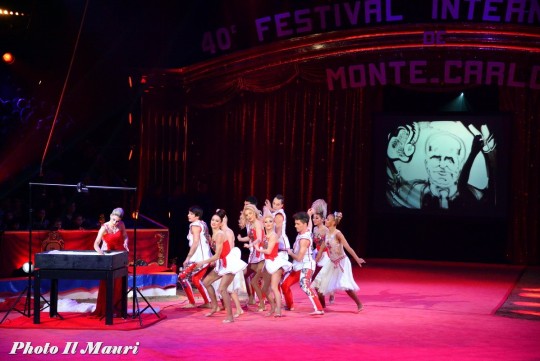
KELLY HUESCA & TROUPE BINGO

HOUSCH MA HOUSCH - BELLO NOCK - FUMAGALLI

TROUPE ACROBATICA DI PECHINO

ROSI HOCHEGGER

BINGO - STARBUGS - SKATING PILAR - SHCHERBACK & POPOV

FLAVIO TOGNI e ALEXIS GRUSS

WILLER NICOLODI
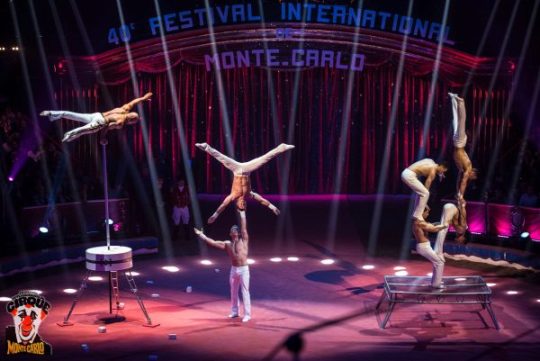
ENCHO - PERES BROTHERS - PELLEGRINI BROTHERS

FLYING TABARES
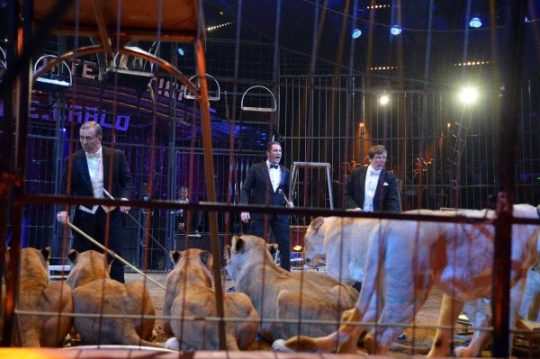
MARTIN LACEY JR - M. NONES - N. PAVLENKO

LAURA MILLER - ANASTASIA MAKEEVA
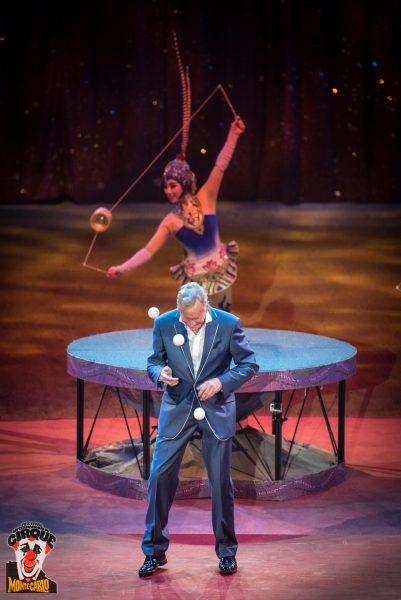
KRIS KREMO - TROUPE DI PECHINO

HOUSH MA HOUSH - STEVE ELEKY

FAMIGLIA CASSELLY
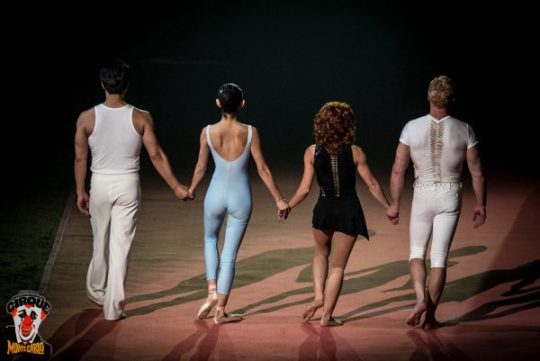
DUO DI CANTON - DESIRE OF FLIGHT

TROUPE SOKOLOV
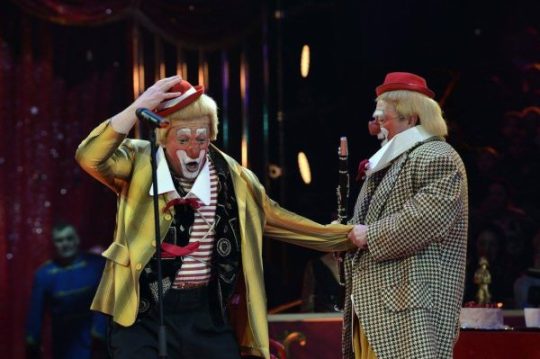
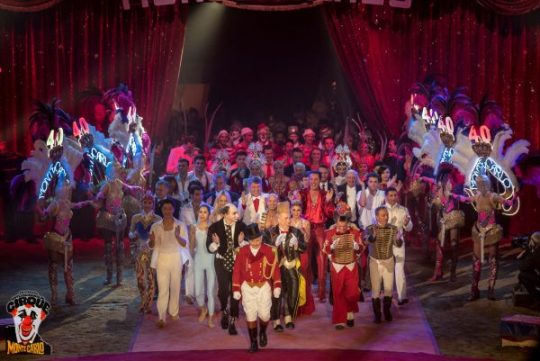

GUARDA LE PHOTOGALLERY DELLO SPETTACOLO
SHOW A
SHOW B
Foto Maurizio Colombo, Dario Duranti, Antonio Vanoli, Andrea Giachi, Charly Gallo e archivi Circusfans
Video Archivio Maurizio Colombo
Visitate la nostra sezione
ALMANACCO DEL FESTIVAL INTERNATIONAL DU CIRQUE DE MONTE-CARLO
ALMANACCO DEL 40° FESTIVAL DI MONTE-CARLO – EDIZIONE 2016
Info Festival Cirque de Monte Carlo
Se questo articolo ti è piaciuto condividilo sui tuoi social utilizzando i bottoni che trovi qui sotto
Read the full article
0 notes
Photo
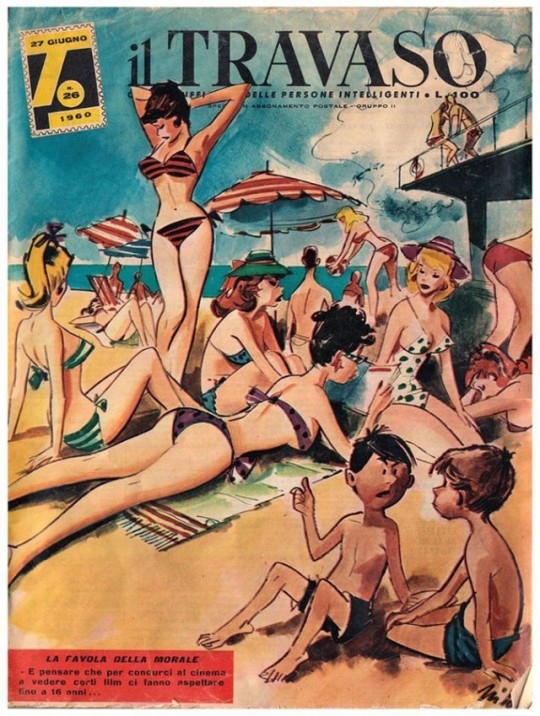
Kremos aka Niso Ramponi (1924-2002) : cover art for IL TRAVASO, june 1960.
Légende:
LA FABLE DE LA MORALITÉ: - Et pense que pour les voir au cinéma, il faut attendre d'avoir 16 ans...
Caption:
THE FABLE OF MORALITY: I say: to see them in theater, you have to wait until you are sixteen ...
#Kremos#Niso Ramponi#italian artist#cartoonist#1960s#beach#girls#beach girls#swimming suit#Il Travaso#illustration#magazine cover#summer time#illustrationisart
18 notes
·
View notes
Text
Wes Peden, juggler: Zebra, London International Mime Festival
Recognised as one of the most innovative jugglers ever, American Wes Peden – who comes from Rochester, New York – has been voted the world’s most popular juggler nine times. His father, Jeff Peden, taught him to juggle when he was five, and they started performing together when Wes was eleven. At 14, he won the gold medal in the International Juggling Association Juniors Championship. He went on to study at the Dance and Circus University in Stockholm from 2007-2010. Wes holds countless juggling world records, won a bronze medal at the 33rd Cirque de Demain festival in Paris, and has appeared internationally from Tokyo to Broadway, including before the King and Queen of Sweden, and at Perlan glacier museum in Iceland.

Based in Stockholm, Wes tours his solo shows and gives masterclasses. UK audiences may have seen him in Water on Mars by Plastic Boom – the company he formed with Tony Pezzo and Patrik Elmnert – and his sizzling guest spot in Gandini Juggling and Alexander Whitley’s Spring. He now returns to the UK, bringing his solo show, Zebra, to the 44th London International Mime Festival. It runs at the Southbank Centre’s Purcell Room from 24-26 January 2020. Wes chats to Liz Arratoon from Helsinki, while rehearsing for an opera.
The Widow Stanton: What is the opera you’re working on?
Wes Peden: It’s a circus opera, CircOpera. They’ve written a story that uses some classic opera songs and lots of different circus disciplines to try to have, like, a fun way to introduce kids and families and people that might not necessarily go to see a traditional opera to the art form.
Do you find that your juggling work is combining more with other art forms now?
Well, I definitely get inspired by other art forms and it’s very often when I’m in group shows it’s not just other jugglers, you know. Gandini has worked with many other types of dance, and I’ve been in shows that have theatre in them or other circus disciplines, and I definitely get inspired by the type of music in the show. For example, opera music, I’m performing to a soloist playing Flight of the Bumblebee on a tuba. That kind of inspires a different sort of juggling than I would ever do on my own. So, definitely.
Let’s go back to the beginning; is or was your dad a professional juggler?
Yeah, he still does perform quite a bit. Before we were juggling together he was already doing about 100 shows a year. When I started getting more and more into juggling we created a duet show, and were performing that for a few years, with many shows around the east coast of the States.

Did it come naturally to you as a kid or was it just a lot of hard work?
Kind of both. I felt like I had a natural talent for it in one way and it made it not feel like work. When you’re young and you learn some things, it doesn’t seem so surprising that you can’t… you don’t get embarrassed that you can’t do anything at all. You can’t juggle, but you can’t ride a bike either. It’s all normal. There are many things you can’t do at that age. Also I was dyslexic and asthmatic, so school was very difficult because of my dyslexia and sport was hard because of my asthma, but then juggling, I was like, ‘Oh, here I am at least on an equal playing field as everybody else’. Having limitations in those other areas kind of pushed me to follow my skill in the juggling world.

How would you describe your juggling style?
The main thing that defines me is that the reason I juggle is to create new tricks, new forms of juggling and to try to make something that someone has never seen before within the juggling world. I want people to come out of my show thinking: “I’ve never seen anything like that. I didn’t know juggling could be like that. Those were some tricks I didn’t imagine would ever be possible.” Because I was lucky enough to juggle for many, many years – 24 years I’ve been practising – I had a lot of time to build a lot of technique. I had a lot of skill with many different props so I try to make these new ideas as technically advanced as I can, to use my full energy and my full skill to make as high-quality new ideas as possible. But what defines my style is creative and new shapes but still a really high skill level.
Were you inspired by any of the great jugglers from the past?
Absolutely. I watch juggling constantly to get inspired by things that have happened already and by what elements I can see, like, ‘Oh, what made that trick so special? What’s important about this juggler’. There are a few jugglers of more recent years, because juggling is still quite young, so lots of the important jugglers are really not that old, they’re still alive. There’s Kris Kremo, who does incredible stuff with balls and hats that really inspires me, and another is Sean McKinney.
I saw him when I was nine years old at this competition where everyone was performing with, like, jazz music, in a vest [waistcoat], kind of in this Kris Kremo-type old-school way but at this time everything was a little stricter for no real reason, and then this guy comes skateboarding on to the stage in jeans and a T-shirt and does incredible new beautiful kind of punk juggling. I was like, ‘What is this guy?’ and he inspired me that juggling didn’t have to be done in just one way. It didn’t have to have a certain aesthetic, that it was broader than I’d ever imagined. So when I saw him at that young age I was like, ‘OK, juggling isn’t this, juggling is whatever you want it to be’.
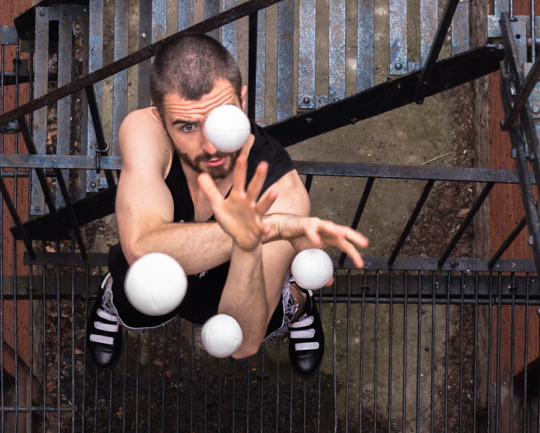
When you’re creating intricate patterns and sequences how do you plan them?
There are certain aspects of juggling that you can do best on paper, for me anyway, and certain aspects that you have to be literally trying it to see what works, where the momentum is and how fast you can move or what makes sense with the flow of where the catches are. So it’s a combination of both. It will often be that I’m working on a trick and then I realise something about it, ‘Oh, the momentum of this part makes me want to throw the ball round there’. I film it on my phone and next time I’m on a plane or a train I look at the videos and ‘OK, now I realise that new aspect of the trick’. I will write down many ideas of how to twist that or expand a new idea. Then next time I’m in training I’ll look at my notebook and try all those new things, film them, so it kind of bounces back and forth between literally work in the studio to see how you body and objects work best together and then more, like, academic work back in the office or while I’m travelling.
You have so many records; it’s not about numbers but how many of each prop do you juggle?
[Laughs] I have some, but to tell you the truth, it gets a little bit tiring, like, trying to add just one more ball or one more club. I might have invented the most five-club tricks that have ever existed but I don’t juggle the greatest number of clubs that has ever been done. I perform seven clubs and seven balls but I try to… yeah… OK, to be able to juggle seven, eight, nine balls you need speed and accuracy and dedication, and how many hours would I need to put in to add one more ball? That would give one image and it would be amazing, but if I took all of those hours and that dedication and then added my creativity to it and instead used that time to try to make something that no one has ever gone for before.
Up until I was, like, 16 or 17, I was going after just the hardest trick, the biggest trick, the most clubs and after I went to circus university and had more classes in dance and composition I started banging my time and my skill more into composing things that are a little bit harder to put your finger on, because when someone says: “How many of this can you juggle,” it’s easier to compute than, ‘Well, I’ve developed this new technique where rings spiral around my arms in hundreds of different ways. By the time you see the end of the piece you’ll have a whole new vision of how things work. It’s a bit harder to envision, but you have to come to see the show’. [Laughs]

Do you prefer one prop to another?
It depends. When I was young I absolutely preferred clubs, like, clubs are the way to be, they can flip this way, the other, rotate, roll… there are many options with them. Then when I started to learn a bit more about how to move my body, I got more interested with balls because you can use them to go around your body, they’re easier going down to the floor and back up. And now I can kind see every prop for what they are good at and if I have an idea of one way of using juggling, like, ‘Oh, this new cross-armed behind-the-neck idea’, what prop will work in that idea best? So now my juggling is more about concepts and then I pull whichever object works with that concept the best. I see them all now like different colours for a painter, whatever is most suitable for this next painting.
What is the best tip you could give to a kid just starting to juggle?
I would say to remember that you don’t need three balls to juggle, you can start with one, or any object and try to invent a trick that is fun; something that you think is cool to do. Maybe take your shoe and throw it up and clap behind your back and you catch it again. Or maybe you can set up some spoons on the table and flip one with the other… not to think that juggling is just getting three balls in the air. Juggling is just a relationship between you and objects and making fun tricks that express yourself. I’d say, make sure you’re having fun and, you know, keep going. You will teach yourself as you invent things and gradually build skill. But always make sure you’re having fun.
You mentioned circus university, why did you choose DOCH?
I was watching lots of juggling videos and different jugglers from around the world and trying to figure out where they all came from and who taught them and where their different styles were developed, and I realised a lot of my favourite jugglers were from Sweden, or Denmark, or Finland. And then I found out that a bunch of them were going to this school, DOCH. The head teacher at the time was Jay Gilligan, who is a very great juggler; a very clever guy in the modern world of juggling. That was it, ‘I already know his work, I want to juggle like the other guys, so let’s go there and study’.
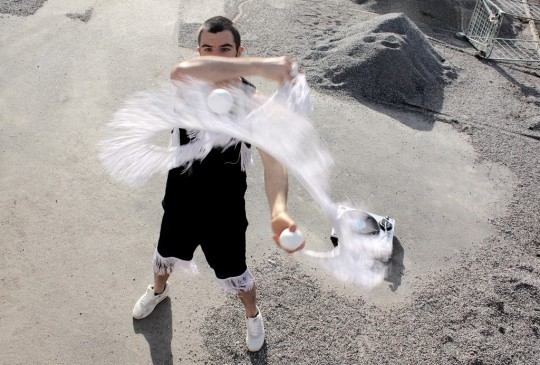
What did it add to your already considerable skills?
When I got to the school Jay explained to me: “OK, we have three years to juggle. We're going to be spending the first year developing your technique and making sure you understand everything you can about literal juggling; the tossing, the throwing, making sure everything is clean. The second year we're gonna teach you how to compose, which will not necessarily have anything to do with throwing and catching.” There were certain things when I was supposed to make an interesting routine while holding a watering can, which I wasn't allowed to throw or catch. You have to forget about your skill as a juggler and just use your creativity to make something good without skill. So for a year I did many different composition exercises, like, 'OK, make 100 tricks in 15 minutes'. You’re like, ‘Uhh!’. It really works your brain in the same way that juggling in previous years had worked my muscles and my muscle memory.
And then in the third year you use your skills developed in the first two, you combine your juggling skill, your composition, you figure out what you want to express and put those skills to work in something from yourself. I think that is the main difference between juggling just on your own and going to a school and having someone make you do composition exercises that really got out the creative side of me and let me develop something that was unique to me.

What happened to Plastic Boom?
The trio performed quite a bit together and then had a contract working in Vegas on a show. The others have stayed there but I got a replacement for my part so I could continue to do my own full shows and live a more artistic career, so we've kind of split ways a little bit.
Are you affiliated with Gandini Juggling?
When they first started to make Spring, me and the two other jugglers from Plastic Boom, all three of us were going to be in the show, but then when we got the offer for the show in Vegas, it kind of was hard to organise with the creation time period of Spring so we jumped out of the project. But then when I wanted to leave Vegas I was partially in the Spring show. I’m good friends with Sean [Gandini], we really share similar visions of why we like juggling, where it can go. We both have energy to develop the art form constantly and now they are my producers.
Did winning a medal in Paris help you?
Yes, it did. In a way, my life is kind of a balance of performing in other group shows, like what I’m in now in Helsinki, and doing my own solo work. And after doing Cirque de Demain I got offers doing some varieté theatre in Germany, where I worked two months a year for a few years. Always while I was just doing an act in another show it gave me an opportunity to be in the same place for a couple of months and really work on the stuff that would be in my next show. In happenstance, after Paris, I got booked for one show in Germany, and I had a huge apartment for that show in the theatre, with a high ceiling, so every day I would spend six or seven hours working on all this new juggling that is now in Zebra. So everything kind of connects… win that, get a good space to juggle, make the juggling for the next show that starts to tour.
vimeo
Tell us about Zebra.
Zebra was kind of a balance based on a show I’d done previously called Volcano VS Palm Tree, which was very explosive and kind of chaotic, and I wanted something more precise where every place my arm was put, every step, every throw was perfectly organised and a bit more, yeah, very, very precise. So this show is about that, and composing juggling with normal juggling objects but in such a way that it doesn’t look like traditional juggling. Let me explain that a bit. For example, there’s a part where I juggle balls where the rule of the whole piece is that it has to be ball juggling where everything is bouncing off my arms. I’ve composed that and developed it over a few years so that by the time you’re a few minutes into the piece it stops to look like ball juggling and starts to look just like elbow bouncing and kind of this new family, this new language of ways of working… to keep it really specific like that.
There’s a piece with five clubs where I’m facing away from the audience and the light is just above my head, so I’ve made the juggling where the only part of it that matters is what’s in the air and you start to forget that I’m throwing and catching and there’s any skill involved because it’s made around watching these waves, or these triangles or these shapes transform into different constellations. So trying to remove the idea of you’re watching it to be impressed and more that you’re watching an idea unfold and evolve and focus more on the content of the ideas within the juggling. In the way you watch a dancer, you’re not, like, ‘Wow, look how high they jump’, but you’re following the idea of what the choreographer is making onstage.
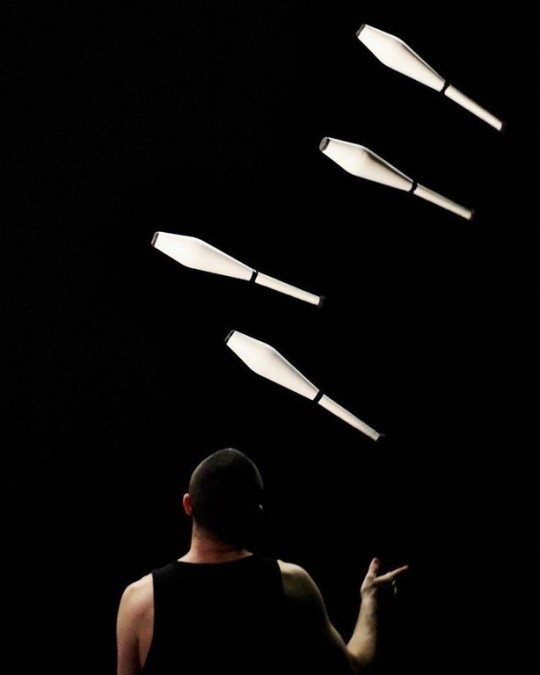
It sounds fantastic! You’ve performed in London before, but how do you feel about being in the Mime Festival?
I’m very excited to be there. Whenever I’m in a festival and can look at all the other shows in the programme and think, ‘I want to go to every single one of these’, I feel at home, and think, ‘Great! I’m in a like-minded space. I’m really happy that my juggling is fitting into a world that I made it for, and I know that the type of audience that goes to these types of shows will see the juggling in the same way that I do’. And I really think that’s it’s a good home for the show. I’m very happy to be part of it.
Can pick out, from your lengthy career, any particular highlights?
I really remember the first time I performed Zebra was in Paris. I’d been working on it for a few years and I really wasn’t sure how it would go, because I was like, ‘Are the people going to respond to this? I’m trying to make something quite different. Is it going to work the same way for them as I see it?’, because sometimes when you’re in your own work for too long, you can’t see it anymore from someone’s eye that’s never seen it before and yeah, when I came offstage and everything had gone so well…
I was also very nervous because the show was all run on vinyl records; there are times when I’m like, throwing them, and bouncing them and if I break one, that’s it. That’s my little twist on the idea of jugging being dangerous, because it’s often dangerous for the juggler, juggling chainsaws or whatever, and now I try to work very closely with the objects and I want to do juggling that a ball would want to do. Or if I was a record, how would I like to be juggled? And now there is danger for the object [laughs]… it could break, and danger for the entire show. But it went OK, I didn’t get so nervous that I broke a record. It went great. That was one of the best feelings I’ve had.
I also make juggling films. I often work for a few years at a time making juggling films that are kind of like skate films, where I collect the coolest tricks and find themes to edit them around and I release those every couple of years for the juggling community. My most recent one is called Gumball, which people can see pieces of on YouTube. When I released that it had been in the works for almost three years and that was one of my highlights that I could make film-specific juggling and had a lot of tricks that I’d never seen done ever before. Yeah, it was like a big expression of who I am and this is how I believe it can be and, here we go, I hope you like it. Sending something like that out to the world feels great.
youtube
Wes appears in Zebra at the Southbank Centre’s Purcell Room from 24-26 January 2020 during the London International Mime Festival
Picture credits: Headshot, Pierre Feniello. Zebra in order, Avi Pryntz-Nadworny; Brend Van Kerckhove; Florence Huet; Luke Burrage; Sonia Sleurs
Wes’ website
For tickets to Zebra, click here
London International Mime Festival, what’s on
Twitter: @WesPeden; @MimeLondon; @southbankcentre
Follow @TheWidowStanton on Twitter
#wes peden#juggler#circus interview#doch stockholm#London International Mime Festival#southbank centre#Gandini juggling#zebra
0 notes
Photo
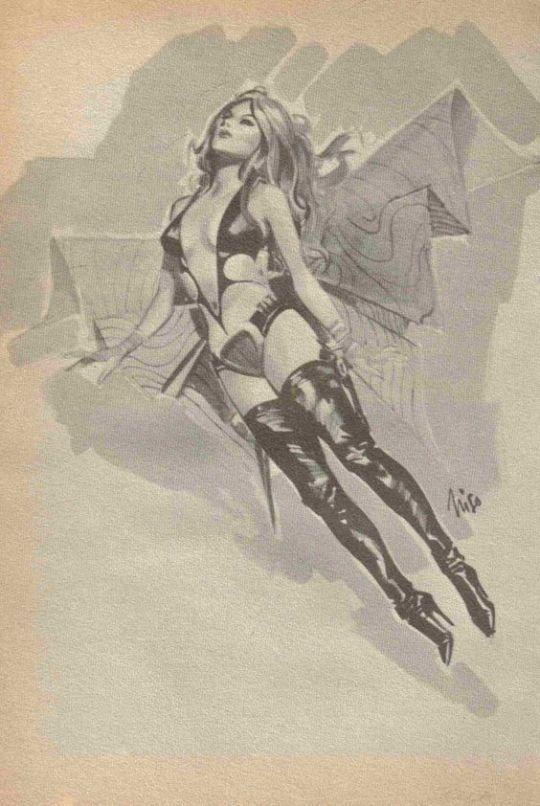




Kremos’s concept art for “Star Crash” (1979)
268 notes
·
View notes
Video
Kremos_Vol1_B+W_FullInterior.indb by Leif Peng
Via Flickr:
Kremos: The Lost Art of Niso Ramponi, Vols. 1 & 2 can be ordered from www.picturethispress.com/
64 notes
·
View notes
Photo
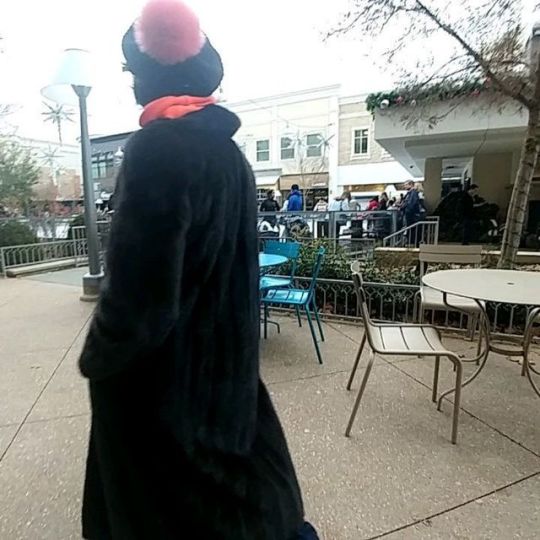
Christmas Eve day at Avalon Mall in Alpharetta for an early din at El Feliz for their Puffy Tacos but they were not serving them today! SAD BUT the food we did eat was delicious and the service amazing. Then bagels at Goldberg's, Ice creme art and eats at Kremo and movie at Northpoint. Dinner and a movie is becoming an Xmas tradition since moving away from home.
0 notes
Text
Spell Check!

Niso Ramponi (‘Kremos’)
#pin up style#pin up art#comic book art#pin up cartoon#good girl art#pulp art#pin up pose#kremos#niso ramponi
35 notes
·
View notes
Text
IL NUOVO SPETTACOLO DI RONCALLI IN UN VIDEO DI R. GUIDERI
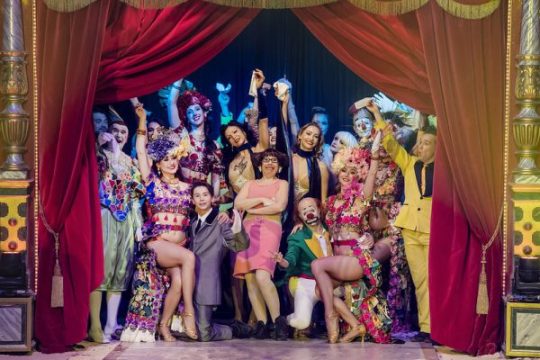
IL NUOVO SPETTACOLO DI RONCALLI IN UN VIDEO DI R. GUIDERI
A marzo, dopo i due anni di stop, ha debuttato il nuovo spettacolo del Circus Theatre Roncalli intitolato “All for ART for All”, uno spettacolo che omaggia appunto l’arte e la pittura e che in alcuni quadri celebra famose opere d’arte che prendono poi vita nei numeri. Dal debutto e nelle piazze immediatamente successive sono intervenuti alcuni aggiornamenti del cast (come la scrittura per Koln di Kris Kremo).
GUARDA IL VIDEO

Tra le attrazioni in scena in questi giorni a Dusseldorf il giocoliere recordman Danil Lysenko, i trasformisti Minasov, la verticalista Maria Sarach, l’attrice comica Krissie Illing con un personale omaggio alla Regina d’Inghilterra, il mano a mano degli Hermanos Acero, la troupe Jump’n’roll (acrobatica alla bascula e salti con particolari molle), l’adagio acrobatico di Vanessa & Sven su un pianoforte a coda, il Duo Luna al cerchio aereo e per quanto riguarda la parte comica Paolo Carillon (accompagnato in alcuni momenti dalla figlia Noemi), il bianco Gensi e Anatoly Akerman.

Nello spettacolo, che denota una notevole cura dei dettagli come nello stile di Roncalli, diverse idee molto raffinate e il recupero di costumi realizzati sulla base di modelli d’epoca disegnati dal pittore e scultore Oskar Schlemmer (che diresse la sezione cultura e teatro del movimento Bauhaus negli anni Venti/Trenta).
Roberto Guideri che ha visitato il Roncalli nei giorni scorsi ha realizzato questo video che riassume lo spirito dello spettacolo e le numerose novità del nuovo corso che sarà in scena a Ludwigsburg (10/08-4/09/2022), Vienna (14/09-9/10/2022, patria del Roncalli), Frankfurt (15/10-13/11/2022) e Bremen (18/11-3/12/2022).





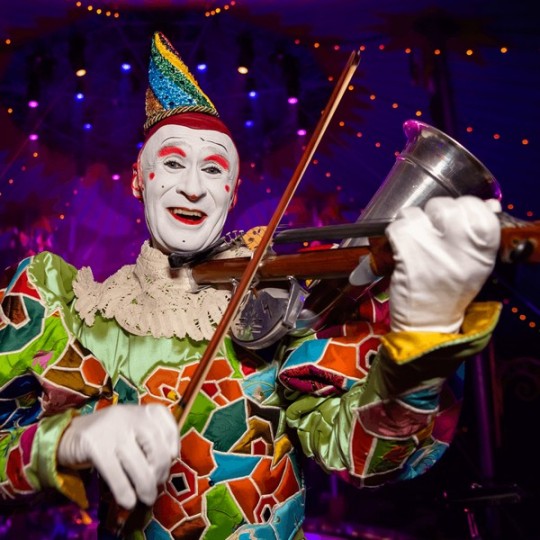
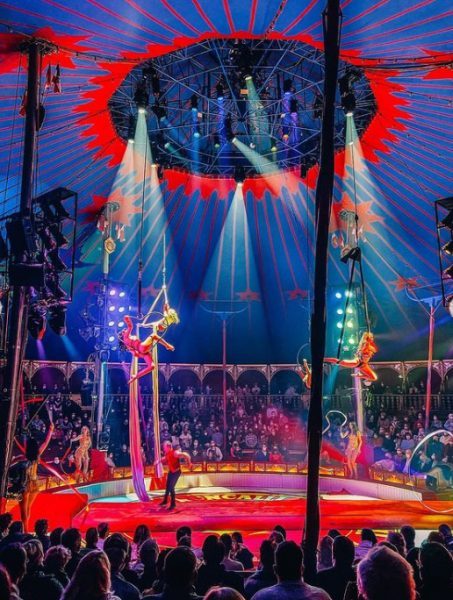



IL NUOVO SPETTACOLO DI RONCALLI IN UN VIDEO DI R. GUIDERI
Se questo articolo ti è piaciuto condividilo sui tuoi social utilizzando i bottoni che trovi qui sotto
Read the full article
#cinetecaguideri#circo#circusroncalli#daniellysenko#gensi#germania#hermanosacero#mariasarach#paolocasanovacarillon#robertoguideri
1 note
·
View note
Text
Este SÍ es mi Santander:IMPOSIBLE no acordarse del Circo ATLAS

Coincidiendo con las Fiestas de Santiago de nuestra ciudad, a las que no faltaba el Circo Atlas, vamos a recordar a los santanderinos hermanos Tonneti, unos de los los más grandes payasos de España.Los hermanos Tonetti fueron dos de los payasos españoles más importantes del siglo XX. En la década de los cincuenta estaban considerados los mejores junto con Charlie Rivel, aquel payaso francés que aullaba a la luna con su traje rojo que le llegaba a los tobillos (que luego imitarían los Aragón. La llegada de su circo a las ciudades estaba considerado como un acontecimiento y se anunciaba a bombo y platillo. La gente hacía interminables colas para lograr una entrada a su espectáculo.
En los Hermanos Tonetti había un payaso listo, el carablanca, y uno tonto. El listo era el de la cara pintada de blanco en la que destacaba una gran ceja negra a modo de interrogación que le daba un aire despierto. Iba vestido todo de blanco con brillos de lentejuelas en la torerilla y zapatos con tacones. El gorro acababa en punta, como para acreditar su tino e inteligencia. Por el contrario, el tonto iba vestido con ropas anchas de colores estridentes y tocado con sombrero chato. Sus grandes zapatos le hacían tropezar a cada paso. El listo no usaba nariz postiza, sino la suya natural, en cambio el tonto, llevaba una gran nariz redonda y roja, y los labios gordos e igualmente pintados. O sea que, por su aspecto, el tonto era muy tonto y el listo, listísimo. Pero como ocurre con la vida misma, al cabo de unos minutos la chiquillada podía comprobar que el listo resultaba ser tonto y el tonto, mucho más pillo que el listo. El tonto era José, el listo Manolo.
A José el mayor de los hermanos, la afición por el circo comenzó cuando era pequeño. Hacer de payaso fue para José Villa su primer juego y, como un juego de niños, se tiznaba la cara y contaba historias a sus amigos de la calle Zapatero, en la santanderina Cuesta de la Atalaya. Pero en casa hacía falta dinero y su padre le empleó en la compañía de electricidad Electra de Viesgo donde también trabajaba él. Sin embargo, su destino estaba escrito y con 12 años colaboró en la Rondalla Katiuska a pesar de la oposición de sus padres: A partir de ese momento, José Villa decidió dedicarse por completo y como profesional al circo.
A comienzos de los 50 se unió a un grupo de artistas y formaron el grupo Hermanos Tonetti, nombre adoptado del célebre clown italiano Antonet y sin que entre ellos hubiera ningún lazo familiar. De esa época es el circo itinerante Radio Circo, que juntos crearon y que más tarde pasó a denominarse Circo Hervás.
La década de los 50 en España son años de esplendor para el circo. José ya estaba triunfando en el mundo del circo y anima a su hermano Manolo, Nolo, que lo hace en el Circo Americano a unirse a él para juntos formar el duo Hermanos Tonetti, ahora sí el dúo circense sí está formado por hermanos de verdad. No tienen vocación de empresario porque los números núnca ha sido su fuerte pero, en 1955 se deciden a montar el itinerante Circo Atlas. El éxito es total y se convierten en el principal competidor del circo más grande que existía: el circo Americano creado por el bilbaíno Arturo Castilla. Por el Atlas pasan figuras mundiales de la talla como, entre otros, Bela-Kremo, Tangarika, Belli, Pinito del Oro que se balanceaba en el trapecio sentada sobre una silla, los Feller, Cesare Togni o Tony Tonito que con 14 años haría el triple salto mortal en los trapecios, el único español que lo ha logrado.
Lo que había empezado modestamente creció hasta convertirse en un auténtico pueblo rodante, con flota propia de transportes y servicios. Junto con el circo Price, afincado en Madrid y el circo Americano de Bilbao, marcaron una época brillante para el espectáculo circense en España. El Atlas realizaría amplias giras por España y participó en multitud de festivales benéficos y actos de caridad. El número de Pepe, la sardinera, les he solicitado allá donde van. Carlos Bacigalupe lo describe de forma cariñosa Inmenso en su sencillez, el payaso aparecía en la pista vestido de pescatera santurzana, que portaba una cesta del rico manjar. Su pregón de las mercancías, sus cuitas con las compradoras, sus críticas aceradas a las vecinas, causaban la risa y el desternille más auténtico. Haciendo el número, Tonetti podía prolongar su actuación el tiempo que hiciera falta, porque para él su trabajo era su devoción y su vicio.
Eran unos profesionales dedicados a su profesión en cuerpo y alma. Como recuerda Alfonso Navalón … Cuando murió su padre, los hermanos fueron a Madrid al entierro. Salieron deprisa y corriendo y volvieron con tiempo de pintarse la cara y estar en la pista para hacer reír a ese público que lo adoraba. Hicieron los chistes de siempre, sus carcajadas y sus piruetas eran más espectaculares que nunca y cuando acabó la función, Pepe se derrumbó sobre un taburete y sus lágrimas de payaso, resbalando sobre los colorines del maquillaje, me llegaron al alma. Desgraciadamente, el espectáculo debe continuar y, como decía la canción italiana:
Ríe tú payaso que esa es tu misiónque importa si adentro te llora el corazón.
Sin embargo, a finales de los años 70 la crisis económica afectó al circo y los hermanos Tonetti, a los que la gente adoraban, permanecieron a duras penas en activo hasta 1982. Como las taquillas no cubrían ya los gastos les organizaron en Santander y en Bilbao algunos homenajes que les permitían tapar un agujero. En 1983 Nolo, se hundió en una terrible depresión y una mañana, pese a estar recibiendo tratamiento psicológico, decidió poner fin a su vida de forma dramática. Cuando Pepe se levantó para hacer sus ejercicios de gimnasia, se lo encontró ahorcado. Tuvo que ser su hermano el que lo descubriera.
Durante un breve tiempo, el mayor de los Tonetti intentó seguir y actuó en solitario reviviendo su personaje de la Sardinera. Pero ésta vez el golpe es demasiado duro y se desanima, poco después decide retirarse. Triste paralelismo con sus representaciones circenses: el tonto, a la postre, es el que sobrevive; El listo, como siempre, es el que pierde.
José Villa del Río fue, junto a otros compañeros de profesión, fundador del Club de Payasos Españoles y Artistas del Circo, de carácter benéfico, con el que actuaron desinteresadamente en numerosas ciudades españolas.
A José, su labor de payaso se ha visto recompensada en numerosas ocasiones. Recibió la Insignia del Club de Payasos, el Premio Nacional del Circo (1972), el Premio Molino de Oro (1977), la Cruz de Beneficencia (1974), la Medalla de Cantabria (1985) y la Medalla de Oro al Mérito en Bellas Artes concedida en 1993 en Consejo de Ministros. En 1996 recibirá el máximo galardón que concede el Ayuntamiento de Torrelavega: la Medalla de Oro de la ciudad. El 19 de noviembre de 1998 recibió, por segunda vez, el Premio Nacional del Circo, que concede el Ministerio de Educación y Cultura.
José Villa, que en su retiro madrileño de la localidad de Algete se dedicó a escribir versos y a la pintura, era padre de una hija, María del Mar. Su hijo Víctor falleció en 1984 a causa de un accidente de motocicleta. Vivía rodeado de todos sus recuerdos del circo, con su rulot aún aparcada delante de su casa como si, en cualquier momento, todo estuviera a punto para actuar esa misma tarde.
Desde 1997 actuó como Consejero del Consejo del Circo para el Ministerio de Educación y Cultura.
En el 2002, pocos minutos antes de entregar los premios que llevan su nombre y que concede cada año la Asociación Amigos de Tonetti, sufrió un infarto cerebral en el Hospital de Basurto (Vizcaya). Desde entonces ya nada sería lo mismo. José Villa del Río, el mayor de los hermanos Tonetti, murió el 20 de febrero de 2004 a los 83 años. Con él moría el Rey. El Rey de los payasos.http://per-can.comMontañeses
1 note
·
View note
Text
Bulgari è una società italiana fondata nel 1884, attiva nel settore del lusso: la gioielleria, l’orologeria, la profumeria, la pelletteria e l’industria alberghiera. Dal 2012 fa parte del gruppo LVMH. Il nome del marchio si scrive generalmente “BVLGARI” proviene dal cognome del fondatore greco dell’azienda, Sotirio Bulgari, 1857–1932), di origine arumena.
La famiglia di gioiellieri Bulgari proviene da un piccolo villaggio dell’Epiro, Kalarites, dove il capostipite, Sotirios, produceva oggetti in argento. Sotirio decise di abbandonare l’Epiro per cercare fortuna in Italia: la prima tappa fu Napoli nel 1881. Un furto improvviso avvenuto nottetempo lo destinò a trasferirsi a Roma nel 1884, anno riconosciuto come l’anno di fondazione del marchio. Assieme al suo socio di allora, Demetrio Kremos, poté esporre le sue creazioni all’interno di una gioielleria di via Sistina. Il successo ed il gradimento della clientela fecero sì che Sotirio potesse aprire pochi anni dopo la sua prima boutique in via Sistina, aprendo poi nel 1895 in via Condotti 28.
Sotirio capì che poteva non limitare la produzione ad oggetti in argento iniziando a produrre oggetti a maggior preziosità. Ispirandosi ai gioiellieri parigini, creò oggetti in platino, smeraldi, diamanti scomponibili; alcuni di essi prevedevano collane che potessero trasformarsi in due bracciali o spille che potevano divenire pendenti. Anche i negozi vennero ridotti di numero in modo da dare a quello di Roma maggior visibilità per renderlo il polo centrale dove venivano curati tutti gli aspetti dalla creazione alla vendita. Dei numerosi figli di Sotirio ed Elena due in particolare seguirono le orme del padre: Giorgio e Costant.
Con l’insediamento degli studios di Cinecittà a Roma, il negozio romano vede quindi sfilare personalità della 7ª arte: Elizabeth Taylor, Marlene Dietrich, Clark Gable, Gary Cooper, Audrey Hepburn, Sofia Loren, Romy Schneider o Gina Lollobrigida. Bulgari apre i suoi primi negozi a New York, Parigi, Ginevra e Montecarlo negli anni settanta. Nel corso di diversi anni l’azienda conserva uno showroom all’hotel newyorkese Pierre Hotel.
Nel 1984 i nipoti di Sotirio, Paolo e Nicola Bulgari, vengono nominati Presidente e Vicepresidente dell’azienda e suo nipote Francesco Trapani viene nominato Direttore Generale. All’inizio del 1990 debutta il progetto di Trapani di diversificare l’azienda, con l’uscita di una linea di profumo Bulgari. Nel 1998 Bulgari lancia la linea di accessori in cuoio e la linea di occhiali.
All’inizio del 2001, Bulgari crea un’azienda comune con la divisione Lusso di Marriott International, che gestisce anche l’azienda Ritz-Carlton Hotel L.L.C., per lanciare un nuovo marchio di hotel di lusso, Bulgari Hotels & Resorts. Bulgari apre il suo primo hotel a Milano nel 2004, una stazione turistica nel 2006 e un altro hotel a Londra nel 2012. Nel 2011 Bulgari Bali viene collocato dai lettori della rivista Smart Travel Asia al secondo posto della classifica dei migliori luoghi di soggiorno in Asia
Il 7 marzo 2011 il gruppo LVMH annuncia di aver acquisito il 51% del capitale del gruppo e nel settembre dello stesso anno sale infine al 98,09% . L’ex direttore di Bulgari entra nel polo “orologi e gioielleria” del gruppo, mentre l’ex direttore di Fendi, proveniente dal polo “Moda e pelletteria”, assume la direzione della gioielleria italiana.
Bulgari è sostenuta da una rete di distribuzione di circa 300 boutique. In Italia il negozio più famoso è quello in via dei Condotti a Roma. La più grande boutique Bulgari al mondo si trova a Tokyo nella “Bulgari Ginza Tower”, 940 metri quadrati di superficie di vendita, che comprende un ristorante e un bar.
Nel marzo 2011 viene concluso un accordo tra la famiglia Bulgari, che detiene la maggioranza delle azioni dell’azienda, e il gruppo LVMH, per effetto del quale il controllo della società passerà alla holding francese.
Lily Aldridge è l’ambasciatrice di Bulgari per la stagione 2016/2017.
La top model è stata presentata alla stampa internazionale da Daniel Paltridge, presidente di Bulgari per il Nord America e da Stéphane Gerschel, direttore internazionale della comunicazione, nel corso di una speciale cerimonia organizzata in occasione della settimana della moda di New York. La nuova campagna che vede protagonista Lily è stata realizzata Mario Testino, fotografo di fama internazionale.
Autore: Lynda Di Natale Fonte: Wikipedia e web
Bulgari #bulgari #bvlgari #gioielli #diamante #lusso #superlusso #perfettamentechic #felicementechic #lynda Bulgari è una società italiana fondata nel 1884, attiva nel settore del lusso: la gioielleria, l'orologeria, la profumeria, la pelletteria e l'industria alberghiera.
#Abiti di lusso#Accessori lusso#Audrey Hepburn#Bulgari#Bulgari Bali#Bulgari Ginza Tower#Bulgari Hotels & Resorts#Bvlgari#Clark Gable#Daniel Paltridge#Demetrio Kremos#Elizabeth Taylor#Francesco Trapani#Gary Cooper#Gina Lollobrigida#Gioielli Bulgari#Hotel di lusso#Lily Aldridge#Lvmh#Mario Testino#Marlene Dietrich#Marriot International#Nicola Bulgari#Occhiali Bulgari#Paolo Bulgari#Pierre Hotel NY#Profumo Bulgari#Ritz-Carlton Hotel L.L.C.#Romy Schneider#Sofia Loren
0 notes
Text

Sexy Scooter!
by Kremos (1951)
#Niso Ramponi#Kremos#pin up cartoon#pin up art#comic book art#Scooter#Motorcycle#Sexy#pin up style#8Otto Magazine
233 notes
·
View notes
Text

Cliffhanger!
by Kremos
236 notes
·
View notes
Text

Susan Morrow
(1952)
#pin up style#pulp art#italian comics#italian magazine#pin up magazine#susan morrow#pin up actress#kremos#pin up girls#8otto magazine
43 notes
·
View notes

